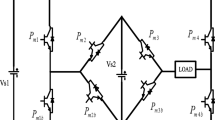Abstract
This paper presents a novel high multilevel inverter topology which is based on the created DC voltage levels at loads of the inverter. The circuit model is demonstrated by explaining the relationship between switches, sources and loads. According to the proposed inverter topology, the number of power switches connected to negative side of DC source is constant on inverter, while the number of power switches connected to positive side of DC sources is increasing. Therefore, linear pulse-width modulation (LPWM) is described for operating switches after pulse-width modulation method is developed to generate the PWM signals. Then, mathematical equations are given when resistive (R), inductive (L) and capacitive (C) loads are connected in series on a 9-level inverter. Finally, the performances of the proposed inverters are observed through MATLAB/SIMULINK simulations after the designed multilevel inverters are simulated. So, 6-level, 9-level and 11-level inverters are compared with voltages, currents and harmonic distortions. Harmonic distortions reduce with increasing level of inverter, while three multilevel inverters are investigated on different modulation indexes. The results demonstrate the satisfactory performance of the inverter and verify the effectiveness of a novel high multilevel inverter topology.










Similar content being viewed by others
References
Jung J, Nam K (1999) A dynamic decoupling control scheme for high-speed operation of induction motors. IEEE Trans Ind Electron 46(1):100–110
Can E, Sayan HH (2016) Different mathematical model for the chopper circuit. Tehnički glasnik 10(1–2):13–15
Rashid MH (1993) Power electronics: circuits, devices and applications, 2nd edn. Prentice Hall, Englewood Cliffs
Cheng C-H (2011) Design of output filter for inverters using fuzzy logic. Expert Syst Appl 38(7):8639–8647
Carrasco JM, Franquelo LC, Bialasiewicz JT, Galván E, Guisado RCP, Prats MAM, León JI, Moreno-Alfonzo N (2006) Power-electronic system for the grid integration of renewable energy sources: a survey. IEEE Trans Ind Electron 53(4):1002–1016
Su GJ (2006) Pulse-width-modulation schemes for an integrated traction and compressor drive system. 21st Applied Power Electronics Conference and Exposition (APEC’06), vol 2. 19–23 Mar 2006, pp. 640–645
Salazar L, Joos G (1994) PSPICE simulation of three-phase inverters by means of switching functions. IEEE Trans Power Electron 9:35–42
Elmas C, Deperlioglu O, Sayan HH (2009) Adaptive fuzzy logic controller for DC converters. Expert Syst Appl 36:1540–1548
Runghimmawan T (2006) Design and implementation multilevel inverter for 3 phase induction motor speed control with RBM chopper technique embedded on FPGA. Power System Technology. PowerCon 200
Sarhan H, Issa R (2006) Improving mechanical characteristics of inverter-induction motor drive system. Proc Am J Appl Sci 3(8):1961–1966
Ramani K, Sathik MAJ, Sivakumar S (2015) A new symmetric multilevel inverter topology using single and double source sub-multilevel inverters. J Power Electron 15(1):96–105
Can E, Sayan HH (2016) PID and fuzzy controlling three phase asynchronous machine by low level DC source three phase inverter. Tehnički vjesnik 23(3):753–760. doi:10.17559/TV-20150106105608
Livadaru L, Simion A, Munteanu A, Cojan M, Dabija O (2013) Dual cage high power induction motor with direct start-up. Design and FEM analysis. Adv Electr Comput Eng 13(2):55–58
Li B, Xu D, Xu D (2014) Circulating current harmonics suppression for modular multilevel converters based on repetitive control. J Power Electron 14(6):1100–1108
Gwon JS, Kim CS, Kang DW, Park JW, Kim S (2014) Voltage source equipment for the grid fault testing and analysis of total harmonic distortion according to PWM methods. J Power Electron 14(6):1081–1092
Kangarlu M, Babaei E (2013) A generalized cascaded multilevel inverter using series connection of submultilevel inverters. IEEE Trans Power Electron 28(2):625–636
Gupta K, Jain S (2013) Multilevel inverter topology based on series connected switched sources. IET Power Electron 6(1):164–174
Rodriguez P, Bellar M, Munoz-Aguilar R, Busquets-Monge S, Blaabjerg F (2012) Multilevel-clamped multilevel converters (mlc2). IEEE Trans Power Electron 27(3):1055–1060
Author information
Authors and Affiliations
Corresponding author
Rights and permissions
About this article
Cite this article
Can, E. Novel high multilevel inverters investigated on simulation. Electr Eng 99, 633–638 (2017). https://doi.org/10.1007/s00202-016-0396-z
Received:
Accepted:
Published:
Issue Date:
DOI: https://doi.org/10.1007/s00202-016-0396-z




